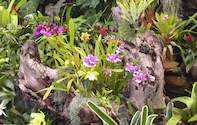A Highly Select Flower
Two things typify the bulbs of the renosterveld - the highly localised home ranges of many species, and the custom-designed nature of their pollinators. One of these unusual interactions is the green-ivory flowering orchid called Pterygodium cruciferum and its own special bee. Because so few of these rare plants have been domesticated, most do not have a common name.

So, for the purposes of this story, and to get around that tricky Ptery-what's-its name, I'm going to call it the Darling Ivory. The Darling Ivory is unique in that it is one of a few highly select species of flowering plants that does not secrete nectar to attract its pollinator - instead, it secretes oil.
The concept if a flower secreting oil is fascinating but the process is not well understood. What kind of physiological differences must a plant have for its flower to produce a short- chain fatty acid instead of the usual sugar water associated with insect-alluring flowers? No one seems to know. This is a flower that evolution has chosen to leave unnoticeable.
The vivid colour or pungent-scented nectar that attracts the everyday pollinator are missing from the Darling Ivory. Honey bees and flies buzz straight past it. Instead, it has evolved side by side with a peculiar oil-collecting bee over millions of years. The bee is nothing like the highly social honey bee whose workers sacrifice themselves for the greater good and have a very sweet mandible.
The Darling Ivory’s Pollinator
The Darling Ivory's pollinator (Rediviva peringueyi) is a solitary bee, lives in clay-type ground and feeds its young on oil 'bread'- which sounds rather provincial but is one of the many fascinating interactions to be found in the renosterveld community. Its specially adapted leg hairs draw up the clove-scented oily 'reward' of the Darling Ivory flower, which the bee then mixes with pollen to make a nutritious bread for its youngsters.
The bee flits from one flower to another, collecting for its larder, all the while taking with it the packages of pollen that guarantee the Darling Ivory another generation of life. This particular bee pollinates about 15 different oil-producing orchids and a few snapdragons.
Each flower must ensure that its parcel of pollen does not get delivered to the wrong species while the bee does its rounds. Masterfully adapted, each flower delivers its pollen to a different part of the bee's body from where it is later collected by the next flower of the same species.
By Leonie Joubert